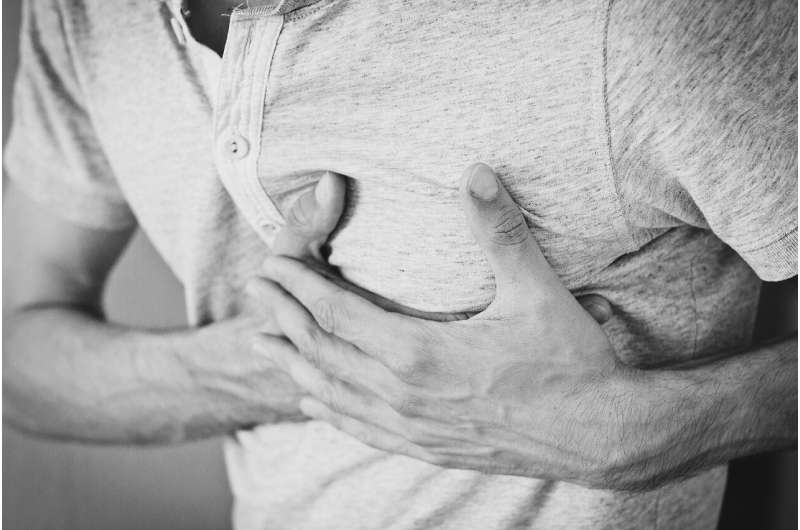This article has been reviewed according to Science X's editorial process and policies. Editors have highlighted the following attributes while ensuring the content's credibility:
fact-checked
trusted source
proofread
Heart attack victims who recognize symptoms are less likely to die in hospital

Recognizing and acting on heart attack symptoms is linked with faster lifesaving treatment, according to research presented at ESC Congress 2023.
"Patients with a repeat heart attack were more likely to know the symptoms than first-time sufferers, but recognition was low in both groups," said study author Dr. Kyehwan Kim of Gyeongsang National University Hospital, Jinju, Republic of Korea. "Most patients could identify chest pain but less than one-third knew the other symptoms."
Heart attack symptoms can include chest pain, radiating pain to the arms, jaw and neck, dizziness, cold sweats, shortness of breath, feeling sick and loss of consciousness. It is crucial to call an ambulance immediately and get fast treatment to survive and make a full recovery. This study investigated the association between symptom recognition, time to treatment, and clinical outcomes.
The study used data from KRAMI-RCC, a registry of myocardial infarction patients in the Republic of Korea. Trained nurses asked survivors if they recognized the following myocardial infarction symptoms: 1) chest pain, 2) shortness of breath, 3) cold sweats, 4) radiating pain to the jaw, shoulder or arm 5) dizziness/vertigo/lightheadedness/loss of consciousness and 6) stomach ache.
Patients were classified as "recognized symptoms" if they could identify at least one symptom; otherwise they were classified as "did not recognize symptoms." The researchers compared patient characteristics, time to lifesaving treatment and survival between the two groups after adjusting for age 70 years and above, sex, education, living with a spouse, previous registration in KRAMI RCC, cancer, dyslipidemia, cardiogenic shock and presence of acute decompensated heart failure.
The study included 11,894 myocardial infarction patients, of whom 10,623 (90.4%) had a first-time event and 1,136 (9.6%) had a repeat event. Of the 1,136 patients with a repeat event, 118 were excluded due to missing data, failure to answer the survey about symptoms, or presentation with cardiac arrest, leaving 1,018 patients for the analyses.
Overall, just over half (52.3%) of patients recognized the symptoms of myocardial infarction. The majority of patients (92.9%) could identify chest pain as a symptom of myocardial infarction, while approximately one-third recognized shortness of breath (32.1%) and cold sweats (31.4%). Just over one in four recognized radiating pain (27.4%), while only 7.5% identified /vertigo/lightheadedness/loss of consciousness and 1.3% recognized stomach ache.
Regarding patient characteristics, men were more likely to recognize symptoms than women (79.3% of men vs. 69.0% of women identified symptoms). Other traits associated with symptom recognition were younger age, higher education level and living with a spouse.
The researchers also compared time to treatment and outcomes between the two groups. Some 57.4% of patients who correctly identified the symptoms of myocardial infarction received treatment to open the arteries and restore blood flow within two hours, compared to just 47.2% of those who did not recognize the symptoms. Patients who recognized symptoms had a lower in-hospital mortality rate (1.5%) compared with those who could not identify the symptoms of a heart attack (6.7%). The group who could not recognize symptoms more often had cardiogenic shock and heart failure.
Among patients with recurrent myocardial infarction, the symptom recognition rate was 57.5% for those previously enrolled in KRAMI-RCC and 43.2% for those not previously enrolled. Just 14.4% of patients with a first-time myocardial infarction could identify the symptoms.
Dr. Kim said, "The findings indicate that education is needed for the general public and heart attack survivors on the symptoms that should trigger calling an ambulance. In our study, patients who knew the symptoms of a heart attack were more likely to receive treatment quickly and subsequently survive. Women, older patients, those with a low level of education, and people living alone may particularly benefit from learning the symptoms to look out for."
More information: The abstract "Effect of symptoms recognition in patients with recurrent acute myocardial infarction: from KRAMI-RCC" will be presented during the session Risk stratification in acute coronary syndromes (1) which takes place on Friday 25 August from 13:15 to 14:00 CEST at Station 5.




















